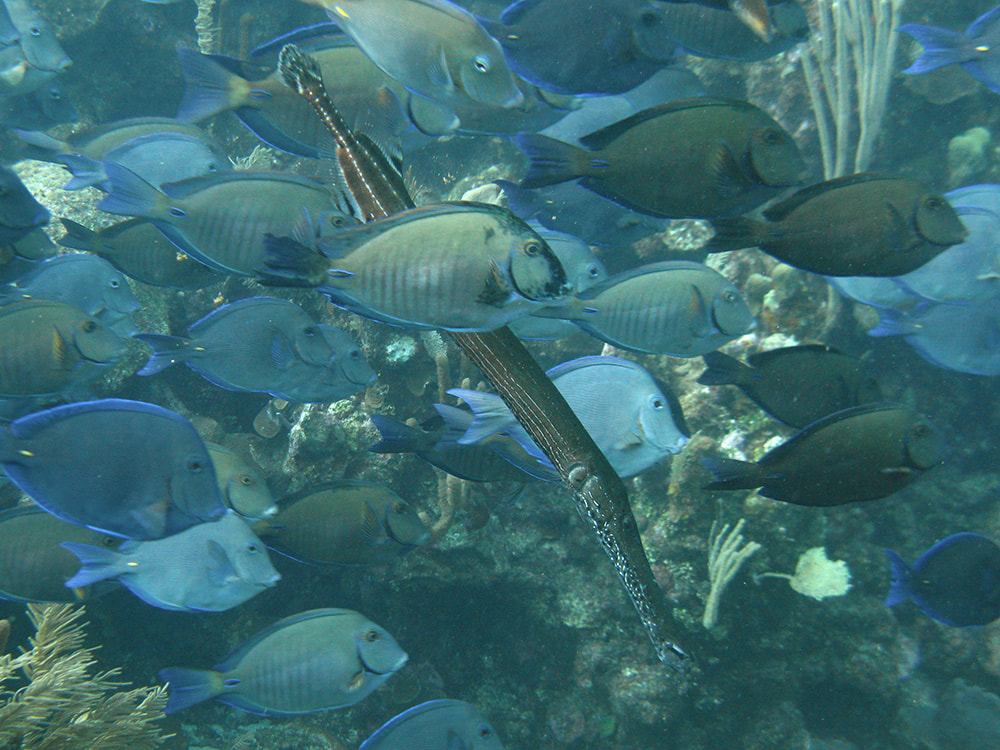|
I'm often asked what my favorite fish is here in the Caribbean. Most people seem to have one, usually something very colorful or oddly cute. But mine has to be the Trumpetfish, it's kind of goofy-looking but has a range of hunting skills that makes it a very succesful predator. A very sneaky fish, they never see it coming... Varieties of Trumpetfish: There is only one member of the Trumpetfish family here in the Caribbean, Aulostomus maculatus. The scientific name comes from Greek, roughly translating to "flute-mouth". They diverged from the Indo-Pacific species (Aulostomus chinensis) around 4 million years ago when the Panama isthmus separated the two oceans. In the Caribbean they are mostly found in reddish-brown, but can also be bluish-gray or even bright yellow, depending on where they are hunting. The dark spots down their bodies can be lightened or darkened to help keep them camouflaged as well. Many younger fishes prefer the shallows, but juvenile Trumpetfish are often found at greater depths, in a bright reddish color that helps them to hide among the stalks of black corals or on deeper rope sponges. Hunting Strategies:Camouflage: They have an uncanny abilty to change thier color to blend in with the reef, but they also change their behaviors and swimming styles to hunt from a variety of ambush points, often hovering upside-down to wait for thier prey. Gorgonians, fans or rope sponges make ideal hiding places and they can swim slowly in a back and forth motion to mimic the swaying of the branches. They feed with an incredibly fast strike, called "pipette feeding", with the mouth often opening as wide as the head. Unlike most other reef carnivores they have no teeth on thier upper jaws; prey is swallowed whole. It's not uncommon to see a Trumpetfish with a large, fish-shaped bulge in it's belly as it digests it's last meal. Shadowing: The Trumpetfish's sneaky personality really comes out when it uses other animals on the reef to hunt from, often swimming next to slow-moving and non-threatening species like parrotfishes or hogfishes in a tactic known as "shadow-hunting". The small prey isn't worried about the approach of a slowly foraging Hogfish, but like a wolf in sheep's clothing the Trumpetfish can get closer to prey before it makes it's strike. Even a cruising lobster can be a good place to hunt from! Their best trick may be to hide themselves within a school of Blue Tang and eventually they can match the same deep blue color of these wandering herbivores perfectly, only breaking cover to dart out and snap up any unsuspecting prey. They often target the juveniles of damselfishes and squirrelfishes but will take adult gobies and blennies or even small shrimps, crabs and other crustaceans. Reproduction: Trumpetfish reproduce in the springtime and they use the same chromatophores on their skin that they use for hunting to attract a mate. These specialized pigment cells go into overdrive at mating time, and they change colors dramatically, often into their best bright green colors. They also shake vigorously to attract a mate, like a fast dance. This usually happens in the shallows, like the group below that were in less than five feet of water on a night dive. Trumpetfish belong to the order Syngnathiformes, the same group of fishes that includes cornetfishes, pipefishes and seahorses. Just like their seahorse cousins, it is the male that will be responsible for most of the work in bringing about the next generation. The female deposits her eggs in a brood pouch on the male's belly. He will then fertilize them and take care of them until they are ready to hatch. Little more is known about the full life cycle of these common Caribbean fish. A Possible Solution? In the Indo-Pacific, Trumpetfish are one of the top predators of juvenile Lionfish. We can only hope that here in the Caribbean our Trumpetfish are learning this trick as well; it may offer some hope for the Lionfish epidemic we are experiencing here. We know they are smart enough to feed on a variety of prey in a variety of ways, and it seems certain that this invasive fish is here to stay. I look forward to seeing my first Trumpetfish eating a juvenile Lionfish. Best to get them before they grow too big and take over a reef ecosystem. So dig in, Trumpetfish! On your next dive, spend some time with a Trumpetfish. They don't seem to mind the company, as a diver can sometimes distract prey for them too. And every now and then turn around and see if you've picked up a "tail". Trumpetfish have a habit of sneaking around behind divers, and just when a little blenny thinks it's safe to come out of it's hole again... the sneakiest fish in the Caribbean is waiting for them.
Enjoy! Mickey Charteris
2 Comments
|
AuthorMickey Charteris is an author/photographer living on Roatan. His book Caribbean Reef Life first came out in 2012 and is currrently into it's sixth printing as an expanded fourth edition. Archives
August 2019
Categories
All
|
















 RSS Feed
RSS Feed